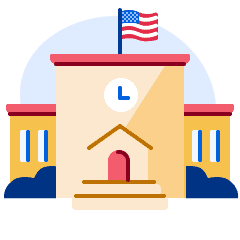Employers in every field are looking for ambitious, self-starting graduates with work experience. Adding industry work experience to your resume can help you stand out to employers and fast-track your career.
If you’re studying in the United States, you may be eligible for three types of work experience: Curricular Practical Training (CPT), Optional Practical Training (OPT), and on-campus work. Below, we’ll look at each of these programs to understand their similarities and differences to help you determine which might be right for you.
Find out more about how to choose where to study in the US.

Work-Integrated Learning Opportunities in the United States
One of the key differences between on-campus work, Curricular Practical Training (CPT), and Optional Practical Training (OPT) is when you may be eligible for each opportunity. Students must complete their first year of studies before they could be eligible for CPT or OPT programs. However, on-campus work is available to students right away.
While you’re studying in the US, you may be able to pursue multiple types of work-integrated learning opportunities. But it’s important to remember there are limits to how much international students can work. Students studying in the US on an F-1 visa can work up to 20 hours per week through CPT, pre-completion OPT, and on-campus employment while class is in session. During the summer break or other scheduled holidays, you can work up to 40 hours per week in total.
You can work any amount through each of these options as long as you stay below the combined maximum. For example, a student might work in the campus library for 10 hours per week and have an internship off-campus for 10 hours per week during classes. In the summer, they could increase their internship to 30 hours per week and keep their library work too.
Now that you know how you can combine various modes of work experience, let’s explore each of these opportunities in more detail!
If you’re planning to apply to study in the US, be sure to check out our US guides on the undergraduate and postgraduate application processes.

On-Campus Work
For F-1 visa holders, on-campus employment is often the most accessible work option. It involves working directly for your university or for on-campus commercial entities that serve students, such as bookstores or cafeterias. Many on-campus jobs offer valuable work experience, such as tutoring other students, working in a science lab, or providing administrative support in a campus office. Plus, many academic institutions reserve a number of campus jobs for current students, which can make it easier to get hired.
- Eligibility: F-1 students are generally permitted to work on-campus without prior approval from the United States Citizenship and Immigration Services (USCIS). However, it’s crucial to consult your university’s Designated School Official (DSO) to ensure you’re following all of your visa regulations.
- Work Hours: Students may work up to 20 hours per week while your program is in session and full-time (40 hours per week) during official teaching breaks.
- Relation to Field of Study: On-campus jobs do not need to be related to your field of study. This can give you the chance to explore different interests and develop diverse skills.
On-campus work experience can contribute to your ability to learn beyond the classroom. It can also provide financial support and help you adjust to the campus community.
Still considering your career options? Find out which emerging careers are projected to grow in the US over the next decade.

Curricular Practical Training (CPT)
Curricular Practical Training (CPT) enables eligible students to participate in internships, practicums, or other work training as part of their program. Sometimes, you’ll need to successfully complete a CPT internship in order to earn your degree. In all cases, your CPT enrolment must be approved by your institution’s international student services office.
- Eligibility: Students must have completed one full academic year of study in the US before applying for CPT (unless your graduate program requires immediate participation).
- Relation to Field of Study: Your CPT work must be directly related to your major and a required part of your academic program.
- Authorization: CPT must be authorized by your institution’s international student services office. This authorization is employer-specific and must be obtained before starting CPT.
- Duration and Hours: CPT can be part-time (20 hours or less per week) during academic terms or full-time (40 hours) during breaks. However, accumulating 12 months or more of full-time CPT will make you ineligible for OPT while you’re studying at the same level.
Whether CPT is a mandatory or optional part of the program, it can offer an excellent chance to gain work experience in your field of study. Plus, you’ll build invaluable skills and can take advantage of networking opportunities.
Learn more about the differences between Curricular Practical Training (CPT) and Optional Practical Training (OPT) before you begin your program.

Optional Practical Training (OPT)
Optional Practical Training (OPT) allows students to find off-campus employment or an internship within their field of study. Students enrolled in a science, technology, engineering, or mathematics (STEM) program can also take advantage of an OPT extension. Before beginning OPT, international students must apply for work authorization with the assistance of their school’s international student advisor.
Two types of OPT are available:
- Pre-Completion OPT allows students to gain experience in their field of study before graduating and entering the workforce. Students can work up to 20 hours per week while studying, and up to 40 hours per week when classes are not in session.
- Post-Completion OPT allows students to work at a job within their field of study for up to 12 months after graduating.
Students who earn an approved STEM designated degree may be eligible for the OPT STEM Extension, which adds an additional 24 months of work permission to their OPT.
While you can participate in OPT prior to earning a degree (pre-completion), it’s more common for students to save their OPT authorization for post-study work (post-completion).
- Eligibility: Similar to CPT, students must have completed one full academic year before applying for OPT.
- Relation to Field of Study: Your job must be directly related to your major area of study.
- Authorization: Unlike CPT, OPT requires authorization from USCIS. Students must file Form I-765 and receive an Employment Authorization Document (EAD) before starting work.
- Duration: Eligible students can receive up to 12 months of OPT. If you’ve completed an eligible STEM degree, you may qualify for a 24-month extension of your post-completion OPT, totaling up to 36 months of work authorization.
Unsure of what to study? Learn more about why studying STEM in the US might be the right choice for you!
Selecting a study program that includes a work-integrated learning opportunity will not only help you build your resume, but also make you more competitive in today’s job market.
Ready to get started? Check out thousands of available programs at institutions in the US with our free ApplyBoard platform.



